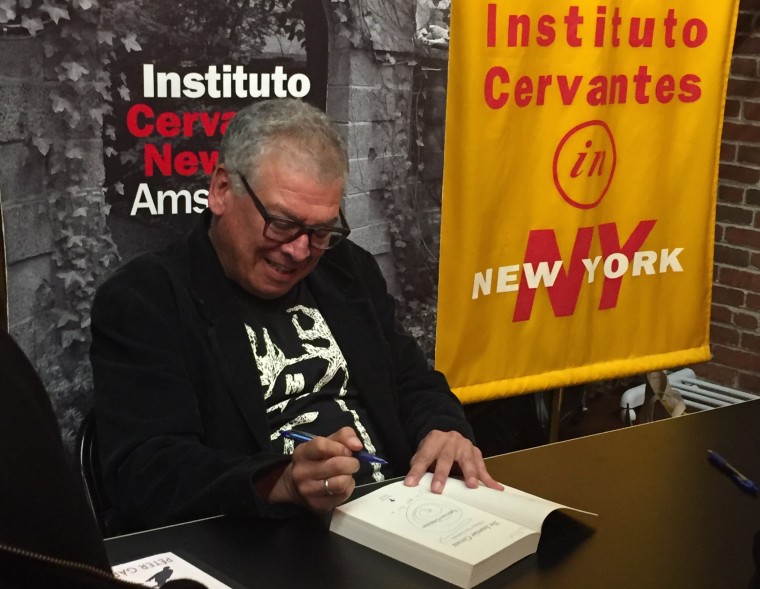NEW YORK, NY -- When acclaimed Guatemalan-American novelist and author Francisco Goldman set out to write his new nonfiction book The Interior Circuit (paperback July 2015), he did not think that his intimate story about coping with the death of his 30-year-old wife would connect him with the pain and suffering of thousands of Mexicans. But in a roundtable discussion hosted by the Instituto Cervantes in New York on Oct. 19th, he described how his grief as a widower brought him closer to many families who have become the victims of drug cartel violence.
The Interior Circuit started out as an article idea about learning how to drive in Mexico City for a travel issue of The New Yorker, said Goldman at the Spanish cultural center. But the theme of learning how to find your way through the roads of this large chaotic city—the book is named after the 30-mile highway that circles the heart of the Mexican capital—set him on an unexpected journey to expand the magazine article into a larger story that would not only pay tribute to his young wife Aura Estrada in a nonfiction sequel to his 2011 best selling novel Say Her Name, but also find a personal voice that chronicles the dark violent side of Mexico.

“I wanted this to be an opposite exercise than "Say Her Name,” Goldman said during the roundtable event. “I am taking the same voice and trying to push the voice further… but each book has its own requirements… so Say Her Name needed me to sometimes fictionalize things because I wasn’t there," said Goldman. "In this book, I was there for everything - things are going to be in this book exactly as they occur.”
The traumatic death of his wife—Aura broke her neck bodysurfing in 2007—posed deep philosophical questions for Goldman, and later his readers in the book—Can we learn something from pain? Is there anything that we have experienced through suffering that can give us meaning? And for the author, "The Interior Circuit," which takes place in the summers of 2012 and 2013, soon carried over naturally to other tragedies like the abduction of 13 people from an after-hours club in downtown Mexico City on May 26, 2013. The mutilated bodies later turned up in a mass grave outside the city, and Goldman would use the experience of his own personal trauma to connect with the families of the missing.
“Partly out of my own compulsion I wanted to get a lot closer to that world of trauma. But I also wondered if I could do anything,” the author said in a phone interview with NBC News. “There was an incredibly helpless desire to be useful… to use my experience [not only] to write about what they [the after-hours club families] were going through, but also understand what is going on in society at large.”
And as Goldman crosses over from describing his own personal grief as a widower to chronicle the trauma of other people in Mexico City, he stumbles upon a much larger story about society.
"The city is full of people - like me who lost their loved ones in a sudden violent way - a huge asylum of people plunged into that abyss of sudden violence," says Goldman about Mexico City.
“I kept reflecting how we keep talking about Mexico City as ‘estamos en una burbuja’ (‘we are living in a bubble’),” said Goldman in the interview. “[But] the city is full of people… like me who lost their loved ones in a sudden violent way - a huge asylum of people plunged into that abyss of sudden violence."
Goldman said Mexico City has been under a myth that the cartels aren’t involved there, but the after-hours club abduction was clearly a cartel crime. "And you saw how it was being covered up…you can feel really powerful forces moving beneath the surface of that crime.”
The author, who links the after-hours club abduction with more recent tragedies not covered in The Interior Circuit—like the disappearance of 43 students in Ayotzinapa, Mexico on September 26, 2014—describes his book as a premonition of the drug cartel violence that now characterizes Mexico.
“The after-hours case really was a paradigmatic case for how Mexico City was changing,” Goldman said in the interview. “[It] reflected a really cruel, horrible violence that happens all over Mexico nowadays… in ways that are often so hidden but we feel them, in ways that the deep narco structures are connected to political groups too and the way they can act together."
RELATED: Inside Mexico's Drug Cartel Crisis
And in this sense, the author explained that "The Interior Circuit" is a chronicle about personal traumas that have set Mexico—and the victims of violence everywhere—in motion, pushing people beyond their egocentric bubbles to work together as better citizens.
“It’s impossible to even put into words… how important Ayotzinapa is to all of us,” Goldman said at the roundtable event with a soft but incisive voice, describing how the trauma of 43 missing students has changed Mexico. He said it was impossible to conceive of this epoch in Mexico City without thinking about Ayotzinapa every day, "without feeling that it is with us everywhere we go - the mothers and the families."
The author described the Ayotzinapa parents whose incredible endurance, leadership and bravery in refusing to back down and preventing the case of their missing sons from being whitewashed as moral leaders in a pivotal moment in Mexico's history. It's been a transformative year, said Goldman, that has set things in motion. And the traumas of Mexican families will pressure people to push for change for a long time.
